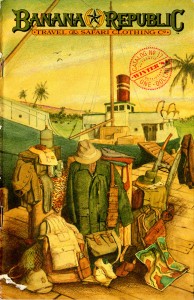You may know Banana Republic as a typical clothing store not unlike the other brand names in their corporate parent’s portfolio, which includes the Gap and Old Navy. Banana Republic is the upscale version; currently they feature a retro-styled line inspired by AMC’s Mad Men show.
But once there was a time when Banana Republic was known as an inexpensive line of funky and unique clothing inspired by military surplus and flea market finds, but better known for its beautiful and inspiring catalog. If you’re under 40, you’ve probably never seen one of these catalogs and probably never knew they existed; it’s been 30 years since The Gap acquired Banana Republic from its bohemian founders and systematically destroyed everything cool about the chain. Let me tell you what you missed. It’s pretty cool, and an example of what artists with a vision can come up with and how easily corporate drones can ruin it.
In 1978, the husband-and-wife team of Mel & Patricia Ziegler found themselves in the clothing business. Having met when both worked at the San Francisco Chronicle (he as a photojournalist, she an illustrator), the couple enjoyed travel, and they also enjoyed buying interesting clothing in little shops around the world. Eventually they began buying these items in bulk and selling them in the Mill Valley area of northern California. Before long, they had opened a store, and not long after that they began publishing their catalog.
The Banana Republic catalog was unlike any catalog you’ve ever seen. First, it had no photos of the clothes, no models posing attractively; instead, it featured beautiful illustrations of the clothing, printed in soft duotone, alongside engaging journalistic stories of exotic locations, adventure and the romance of travel.
By 1983, Banana Republic had five stores in California, a handful in other locations, and was bringing in $10 million a year from ghurka shorts, madras shirts, Israeli paratrooper bag, photojournalist’s vests and a variety of khaki trousers. They attracted the attention of The Gap, and for a while, the Zieglers stayed on with the company to oversee the operation. Before too long, the new owners decided they could make more money by rebranding the chain as an upscale line, ditching the funky military clothing and safari-themed decor, killing the catalog, and just generally turning a unique enterprise into just another clothing store.
I was going to scan some sample pages from the small collection of old Banana Republic catalogs that we kept because they are just too dang cool to throw out, but then I discovered that somebody else has already done a far better job of it. Scott C. Adams, an animation background painter from Oakland, California, has created a wonderful archive of scans of the catalogs and written several articles about the company. I highly recommend that you pop by and see what you missed out on.
The Abandoned Republic site includes articles by Banana Republic staff artist Kevin Sarkki and production artist Mike Madrid, who provide a look into the daily operations of Banana Republic under the Zieglers. Madrid went on to a long career as an art director at Gap, but Sarkki left after less than four years with the company, chafing under the change of management as the corporation took over the operation. “The Gap stores demanded an upscale, urban look and feel-slicker and slicker-until the original concept of anti-fashion was superseded by fashion,” Sarkki explains.
For its time, Banana Republic was one of the most successful examples of niche marketing; one can only imagine how much more successful they would have been, had they been able to exploit the instant communication and global reach of the Internet.
If you’ve got a unique and wonderful idea for a business that makes the world a more fun place, that adds a bit of magic and color to your customers’ lives, please resist the temptation to sell it for a lot of money to the philistines who hate magic and despise wonder.




Pingback: Banana Republic in the ’80s | Blue Collar, Black Tie
“Please resist the temptation to sell it for a lot of money to the philistines who hate magic and despise wonder.”
That’s exactly what happened to Rhino Entertainment. The owners sold 50% to Warner Bros. Within a year, they were gone, and whoever hears about Rhino, for many years voted one of LA’s best places to work. Meanwhile, former co-owner had been nourishing
Shout Factory!, which seems to be very similar to the old Rhino.